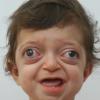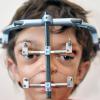Crouzon syndrome is a genetic condition that is characterized by premature closure of calvarial and cranial base sutures as well as those of the orbit and maxillary complex (craniosynostoses) that give its characteristic appearance.
FREQUENCY AND ETIOLOGY
Crouzon syndrome is caused by multiple mutations in the FGFR2 gene, which may be inherited from the parents or are new mutations. The incidence of this syndrome is approximately 1: 60,000 births.
CROUZON SYNDROME CHARACTERISTICS
- Brachycephaly (where the head is short in the anteroposterior dimension).
- Facial hypoplasia.
- Exophthalmos or exophthalmia (bulging eyes) that can be so severe that the patients cannot close their eyelids.
- Increased distance between the orbits (eyes) (hypertelorism) that usually is not severe.
The clinical picture can range from very mild (which may escape diagnosis) up to severe, incompatible with life.
MENTAL DEVELOPMENT
In most of the cases, people with Crouzon syndrome have normal mental development (or normal intelligence).
FUNCTIONAL PROBLEMS THAT ACCOMPANY THE CROUZON SYNDROME
- Increased intracranial pressure (ICP) due to the lower cranial capacity. This is a very common problem and may occur at any time, with serious consequences.
- Decrease or loss of vision that is usually caused by increased intracranial pressure (ICP).
- Eye irritation due to eyelids closure weakness. This can create permanent corneal damage.
- Breathing difficulty, especially during sleep (nocturnal obstructive apnea). In the severe type, it is incompatible with life. Even in the mildest types it can create significant problems (disturbed sleep, daytime sleepiness, inability to concentrate).
DIAGNOSIS
The diagnosis is made by physical examination and is confirmed by genetic identification. The genetic identification is a time consuming process and becomes positive in only half of the cases, but this is not so important because the confronting of the problems is done according to the findings of the physical examination.
ASSESSMENT OF A NEWBORN WITH CROUZON SYNDROME
Immediately after birth, it should be assessed the following:
- Respiratory function. If there is a breathing difficulty that continues after initial support in the intensive care unit then it may be required tracheostomy.
- Eyelids closure capacity. If the newborn cannot close his/her eyelids because of exophthalmos (eyes bulging out of their sockets), it may need to perform a temporary tarsorrhaphy (where stitches are carefully placed at the corners of the eyelid opening (palpebral fissure) to narrow it) so as to protect the cornea up to solve the problem permanently.
- Intracranial pressure (ICP). Rarely need to take immediate measures to confront it. The cases in which is required to perform an emergency surgery are extremely serious and nearly incompatible with life.
CROUZON SYNDROME SURGICAL REHABILITATION
Because almost always there is a limitation of the cranial capacity and the brain undergoes some pressure, this pressure should be alleviated in infancy with expansion (enlargement) of the cranial cavity.
- Usually, the initial surgery is performed on the back of the cranial area i.e. to the parietal-occipital region (Occipitoparietal Decompression).
- A few months later (if necessary), it follows a decompression in the frontal part of the skull (Frontal Orbital Advancement). In this surgery, it is formed the orbital area and the exophthalmos is somewhat reduced.
- Finally, at age of 10-12 years it is achieved a complete and permanent correction of malformation and functional problems moving the frontal part of the skull and face forward (Frontal Facial Advancement).This surgery can be performed at an earlier age, if necessary due to the functional problems that require immediate solution (obstructive apnea, increased intracranial pressure that causes vision impairment).
Although, all these problems seem to be unsurpassed and it is very natural to be a source of significant anxiety for parents, however, with regular visits in a well-organized Craniofacial Center, their treatment is accomplished properly and with the minimal discomfort for the child and his/her family.





